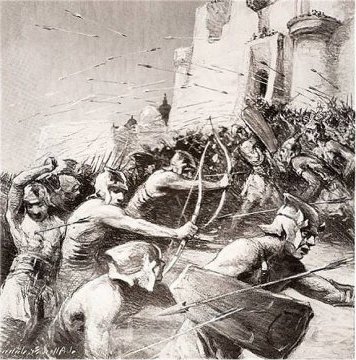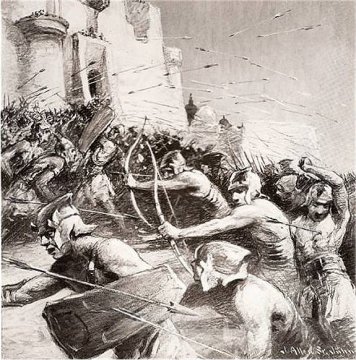INTRODUCTION
I had some training as a Combat Archer in the very early 1970s, giving
up the sport until about 20 years later when I found my old Longbow in
a storage shed I was cleaning. I spent a week or more oiling that
bow and when I felt that it was refreshed, I strung it, warmed the limbs
and did a test draw and my Longbow that had stood me so well in a few battles,
suffered a "catastrophic failure" which means that the upper limb snapped
and slapped my eye with a rapidly moving bowstring and wood splinters.
Only my glasses saved me from blindness, though that was the eye in which
I took some shrapnel so no big loss. However, that incident reignited
my love for archery and from then on, I made my own gear, purchasing recurves
and bare-bows, even having a few specifically built for me and making my
own. Note that I am talking about Traditional Archery here.
Fortunatly for this paper, one never really understands archery until you
actually are in a position to design and make your own gear.
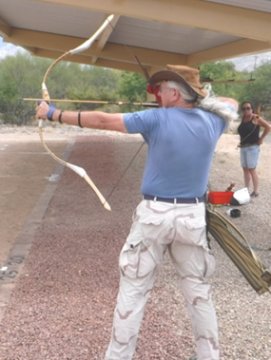
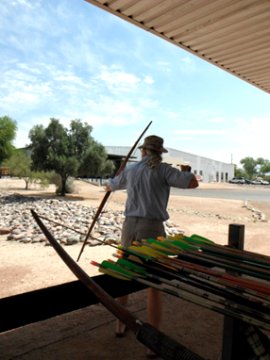
My horsebow and Longbow, both I built from kits.

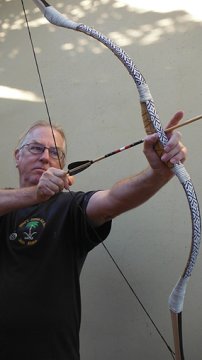
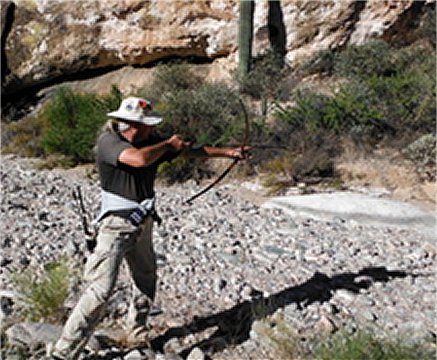
My horsebow and 42” Survival Longbow, both built from kits.

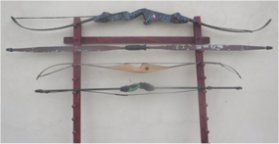
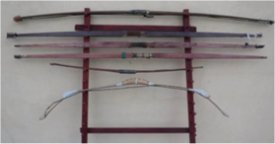
A few modern and Traditional Bows in my collection

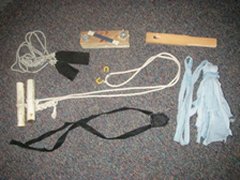
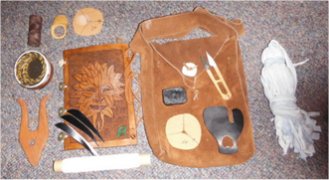
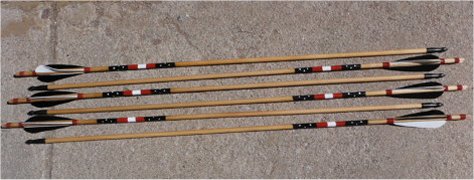
Gear and arrows that I make.

I have even invented a few archery fletching tools and am experimenting
with new designs for birding and varment hunting arrows, making my own
arrowheads and it is while making these heads, I thought about Kar Komak.
What kind of bow would he have used?
BACKGROUND
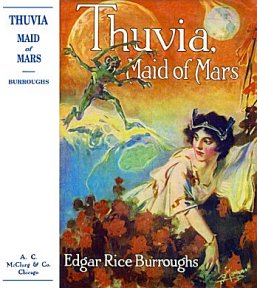
First edition cover art
by P. J. Monahan
|
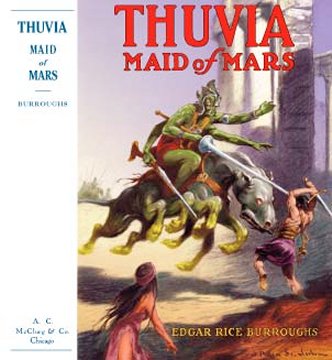
Modern cover art redesigned by Phil Normand
using J. Allen St. John art
|
In Thuvia, Maid
of Mars, Thuvia and Carthoris enter the city of Lothar after
observing an army of bowmen rout the Green Hoard of Torquas from which
they had recently escaped.
And then the great gate in the city wall
opposite the platform of Hortan Gur (the Jed of Torquas) swung suddenly
wide. From it issued as strange a sight as Carthoris ever had witnessed,
though at the moment he had time to cast but a single fleeting glance at
the tall bowmen emerging through the portal behind their long, oval shields;
to note their flowing auburn hair; and to realize that the growling things
at their side were fierce Barsoomian lions.
Between them and the city raged a terrific battle.
The fair-skinned warriors, armed only with their long bows and a kind of
short-handled war-axe, were almost helpless beneath the savage mounted
green men at close quarters; but at a distance their sharp arrows did fully
as much execution as the radium projectiles of the green men.
Shortly after, they realize that the dead upon the field are only Green
Men and that the Bowmen of Lothar have vanished, living and dead.
This is explained by Jav, a Lotharian they meet, that the Bowmen have no
real existence but are naught but mental constructs from the memories of
the Lotharians and that the inhabitants of Lothar have lived within those
walls for thousands of generations, since the seas receded. Needing
protection from the Green Hoards, they mastered mental projection and created,
within the minds of the Green Men, the thought of Bowmen, the thought of
arrows being released and the thoughts of those arrows piercing their hearts.
Killed by their own belief in the images, the Green Men retreat and Lothar
is safe.
What this tells us is that the ancient Bowmen of the Orovars were armed
with a Bow for range and for in-close fighting they used a short-axe with
large oval shields for defense. Kar Komak explains this later:
"I am Kar Komak, odwar of the bowmen,"
replied the other. "A strange thing has happened to me. For ages Tario
has been bringing me into existence as he needed the services of the army
of his mind. Of all the bowmen it has been Kar Komak who has been oftenest
materialized.
"For a long time Tario has been concentrating
his mind upon my permanent materialization. It has been an obsession with
him that some day this thing could be accomplished and the future of Lothar
assured. He asserted that matter was nonexistent except in the imagination
of man—that all was mental, and so he believed that by persisting in his
suggestion he could eventually make of me a permanent suggestion in the
minds of all creatures.
"Yesterday he succeeded, but at such a time! It
must have come all unknown to him, as it came to me without my knowledge,
as, with my horde of yelling bowmen, I pursued the fleeing Torquasians
back to their ochre plains.
"As darkness settled and the time came for us
to fade once more into thin air, I suddenly found myself alone upon the
edge of the great plain which lies yonder at the foot of the low hills.
"My men were gone back to the nothingness from
which they had sprung, but I remained—naked and unarmed.
"At first I could not understand, but at last
came a realization of what had occurred. Tario's long suggestions had at
last prevailed, and Kar Komak had become a reality in the world of men;
but my harness and my weapons had faded away with my fellows, leaving me
naked and unarmed in a hostile country far from Lothar."
Ok, it is clear that the Lotharian Jed succeeded in creating living tissue,
but was unable to create clothing or weapons. THIS is a thought for
a later paper. But who is Kar Komak? Is he simply a construct
or did he have an actual existence?
"Good!" exclaimed the other, when he
had done. "Kar Komak will accompany you. Together we shall find the Princess
of Ptarth and with you Kar Komak will return to the world of men—such a
world as he knew in the long-gone past when the ships of mighty Lothar
ploughed angry Throxus, and the roaring surf beat against the barrier of
these parched and dreary hills."
"What mean you?" asked Carthoris. "Had you really
a former actual existence?"
"Most assuredly," replied Kar Komak. "In my day
I commanded the fleets of Lothar—mightiest of all the fleets that sailed
the five salt seas.
"Wherever men lived upon Barsoom there was the
name of Kar Komak known and respected. Peaceful were the land races in
those distant days—only the seafarers were warriors; but now has the glory
of the past faded, nor did I think until I met you that there remained
upon Barsoom a single person of our own mould who lived and loved and fought
as did the ancient seafarers of my time.
How could this be? If Kar Komak actually lived, how could Tario recreate
him as he was with all his former memories? Or is the construct ‘kar
komak’ simply thinking that he previously existed? Again, another
paper.
Originally I believed that the Lotharians had created their 'ideal'
Bowman based on their memories and so the weapons of the materializations
would be imperfect. Yet Kar Komak IS Kar Komak and not some imaginary
being. Thus, by implication, the weapons of the Bowmen of Lothar
should be equally real and accurate. So what would the Bows of Ancient
Barsoom be?
Burroughs mentions only "their long bows" Not Longbow but a long
bow! There is a difference. Were the limbs symmetrical as in
any European bow or asymmetrical as in the Japanese Yumi? Were the
limbs straight as an English Longbow or curved as in a modern fiberglass
recurve or a recurve-decurve as in the Asian horsebow? Was the bow
made of one material as in the Yew Longbow or multiple layers of differing
materials as in a wood-core/fiberglass bow? Did it have a bare handle
or a deeply formed pistol-like grip? And we won't even talk about
the arrows though we will touch upon the bowstring. So many questions!
So few answers! But there is a way!
STICK AND STRING, WHAT
IS A BOW?
Very loosely, a Bow is little more than a stick that stores energy
which is transferred via a string to the arrow to provide a devastating
impact upon the target. And a basic bow is virtually universal on
Earth, only minor variations being made. Any archer can go anywhere
on earth, any time in history, pick up the local bow, instantly identify
it as a bow and use it immediately with no specialized training.
Bows are that universal. Thus, we may assume that the same patterns
will be followed on Barsoom.
Thus, we will ignore exotic bows such as the double limbed and the Compound
bows with pullies and gears and focus on the bare bow, be it Self or Composite.
A Self-Bow is a bow made from one material, usually wood. A Composite-Bow
is the same thing only with a few things added such as horn or fiberglass
to make the wood springier and stronger. EVERYTHING else is just
fudging with this to make the bow better able to toss an arrow downrange
better faster and harder under different conditions.
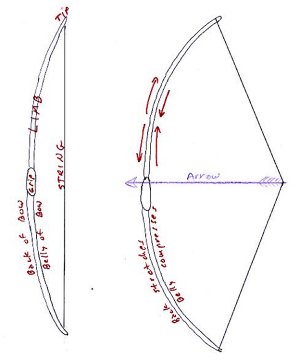 So here is a basic bow.
So here is a basic bow.
-Someplace in the middle is the GRIP, this is where you hold
the thing. Most of the time the Grip is in the middle or just below
the middle.
-Extending from the Grip are the LIMBS. One up and one down.
These are the power of the bow. In some bows they can be removed
for travel or storage.
-At the ends of the Limbs are the TIPS and this is where the string
attaches. Some bows made from softer woods require a tip. Harder
wood bows do not.
-The part of the Limbs that face you when you hold the bow is the BELLY.
The part of the Limbs that is away from you when you hold the bow is the
BACK.
-The STRING is what converts the Compression of the Bow into forward
motion.
That’s it! Everything else is irrelevant to this description.
Now, how does this work?
When you draw the string back, the Belly of the Bow COMPRESSES, sort
of like pushing a spring. The Back of the Bow STRETCHES, like an
elastic band. Since both of these forces are unnatural, the Bow attempts
to return to normal by decompressing the Belly and by recompressing the
Back. When it does this, the String snaps forward and all that stored
up energy in the Limbs is transferred to the String which transfers it
to the Arrow! And ZINGGGG!!!! 30" of steel-tipped wood comes at you with
a velocity of around 150 miles-per-hour with all that kinetic energy impacting
you in a fraction of a square inch. Basically, that arrow punches
a hole through your clothes, body armor, body and spine with devastating
effect composed of hydrostatic shock and massive tissue damage from the
razor-sharp arrowhead!
Now there are many ways of increasing that force. A Traditional
English Longbow is made from Yew which is cut from the outer layers of
the Yew Tree. The part that is next to the bark of the tree resists
stretching and the part that faces the center of the tree resists compression
so you have a pretty good potential weapon. Trivia Note, the English
preferred to buy Yew from Poland as Polish Yew was better than English
Yew.
My Longbows shown above are made from Hickory which is less expensive,
less toxic and more durable than Yew. Also Hickory can be shaped
into a Flatbow to give more power in a shorter limb. A true Longbow
has a “D” shaped cross-section which thins to the tips, forcing the Longbow
to be longer to reach a heavier draw. Basically, the English Warbow
was 7' long and had a 125# draw! A hickory flatbow could do the same
thing in 5'. So wood is the material of choice for bows but different
woods produce different results. Orangewood makes a decent bow but
fails after a year or two. A Yew bow can survive for lifetimes!
You get to choose the wood you want based, mostly, on what you can find
growing in your area.
Now there are ways to increase a bow;s power. Glue a strip of
Ipe or Bamboo to the back of a bow and the power of that bow increases
substantially. Once you do so, your SELF BOW (a bow made of one material)
becomes a COMPOSITE BOW (a bow made of multiple differing materials).
Both of those Longbows you see in the photos are actual Longbows with
a D-section. Both are of Hickory and both are 45# @28". This
means that if I pull the string to 28 inches past the normal resting point
of the bow (the first drawing), then I am using enough strength in my right
arm equal to picking up a 45# weight! Try holding a 45#
weight at arm’s length and see how long you last! This is why real
archers rarely hold their bow at draw for more than a second or two.
Yes, the movies lie! Robin Hood never held a 60# Longbow at full
draw as he faced down the Sheriff’s men.
Were I to glue a backing to these bows, I could easily turn them into
60# or 100# bows. But why? I can take down a deer or bear or
man with a 35# bow so why break my back with something heavier when 99%
of my archery time is plinking at a target!
Asian Horsebows (see above pics) were different. Why? Because
they had no decent trees! Try to find a large tree on the steppes!
So the Tartars, Mongols, etc had to make a bow from shorter bits of wood.
But because a deer on the steppes can see you pretty far away, they had
to figure out how to make those short bows more powerful. And so
they began to back their bows and created a Composite Bow. Most Horsebows
are thin strips of horn and sinew (those ligaments behind your knees and
ankles) glued to wood bows. Sinew stretches but springs back, horn
bends and springs back. Thus you have a powerful bow in a length
short enough to carry on a horse. Remember that you have to move
that bow from side to side and the longer the bow, the more often the horse
gets in the way.
So why didn’t the Western Europeans make Composite Bows if they are
so versatile and saving of trees? Humidity! No one had a glue
that would survive the wet European climate. A Mongolian Horsebow
would delaminate in England and there you have another catastrophic failure!
Bows were designed and made from local materials and for local conditions.
THIS is important when we cover Martian Bows.
So how does this relate to Barsoom?
MARTIAN ARCHERY
When Barsoom dried and the seas vanished, so did most of the plants
and animals. Now we can imagine that Ancient Barsoom had a tree that
was perfect for a superbow, a wood that compressed and decompresses after
storing energy so at full drawn it is barely 15# but when released, decompresses
with 100#! But really, let’s try to be real here.
GRAVITY!
Mars has a gravity that is only 38% of Earth. As Den
Valdron has mentioned often enough, thoats are skinny, thin animals
because they do not have to fight gravity. In A
Princess of Mars, Tars Tarkas at a dozen feet tall was so skinny
that when he gave John Carter an armband, it fit the Earthman. The
average Thark was described as maybe 500 pounds but compare that to Andre
the Giant who was only 6’ 11” and weighed easily that much! So Martian
creatures were tall and thin as they had no reason to fight a heavy gravity!
So also would be the trees! Lacking Earth’s gravity, the trees would
not need strength to grow tall. Skeel probably took a thousand years
to grow six feet. Soropus probably grew faster but was much weaker.
These are the woods we know so I will work with these. Yes, the Koal
and Manator forests had more types of trees, but they are undescribed so
we’ll have to ignore them until someone finds Captain Carter’s lost journal
of the Flora and Fauna of Barsoom.
Remember, also, that the Red Man was no massive superman. They
were six feet all but only needed to be strong enough to move about in
0.38G. They resembled humans in build because no one mentions JC
as being some massively gigantic weightlifter in size, but their muscles
were weak. Not one could equal John Carter in strength so we can
calculate that there were no 125" warbows on Barsoom. I am thinking
20-30# tops! But as slight as were their target people and animals,
you didn’t need any more power. Remember my comment that I could
stop a bear with a 35# bow? Check your local bowhunting laws and
you will find that most places only require a 35# bow to hunt deer!
It doesn’t take much and a 35# bow can send an arrow at far more than 100
mph which will easily kill. . . well, almost anything you are likely to
meet. Probably not an elephant or charging rhino, but almost everything
else. You can drop an elk with a 60# bow, but you’ll find an exit
hole on the other side and spend an hour or two looking for your arrow.
And when you spend $10-20 for a good arrow, you don’t want to lose it.
So use a lighter bow and pull the arrow from the body. THIS is why
I learned how to make arrows and am learning how to make arrowheads.
I simply cannot afford to pay $125 per half-dozen for decent arrows!
And as the Red Man had not enough strength to pull anything stronger
than a modern youth bow, a Barsoomian Bow did not need much power to drop
those fragile animals and people!
So now that we have covered the weight of the bow, a lot of the problems
we had to solve on Earth vanish.
WOOD!
Most bows are made from wood, or some combination of wood and other
materials. Dense and heavy and strong woods do not grow fast.
When I started in construction, most framing was done with pine 2x4’s.
These trees grew slow and strong. Then when we clear-cut the forests,
we had to buy wood that had been force-grown by the lumber mills, trees
that had been grown so fast they often snapped under load. So a tree
that grows slow is strong. But too strong and it loses its flexibility
and snaps. You need a good balance between too soft and too hard
and Soropus sounds ideal. I imagine that you can make a decent bow
up to 30# with soropus which would stop a thoat or a Green Man.
If you felt the need to increase the power, you would back the bow with
something else. Possibly a thin layer of skeel in the same manner
as gluing Ipe or bamboo to the back of a flatbow.
We know of no horned animals on Barsoom. Perhaps they all became
extinct, perhaps they may live in the Korests of Koal and Manator and the
Valley Dor, but without any mention, I am going to avoid climbing out upon
that limb and suggest another option. Leg bones! Lacking the
need for strength, the leg bones of the thoat could be thin and springy.
Cut a long thin leg bone from a thoat into strips, clue these to the back
of a soropus bow with or without thoat leg ligaments as binding and you
could drastically increase the power of that bow. Such a composite bow
would do well in the dry Barsoomian environment though not aboard a ship
where the air would be far too moist for the glues.
STRINGS
Modern strings are made from dacron though more natural fibers are
popular. All you need is a cord that will NOT stretch, much!
In Asia they make bowstrings from silk. In Europe strings are made
from any number of natural fibers such as: linin, hemp, sinew, rawhide
and even silk. The only properties needed are resistance to stretch,
the ability to bind together and resistance to abrasion at the tips and
arrow-nock. Most bowstrings are whipped at the ends and nock-point
to protect the actual string. Silk is frequently mentioned in the
Mars novels so I would suggest that bowstrings were made from a combination
of silk and sinew.
CONCLUSION
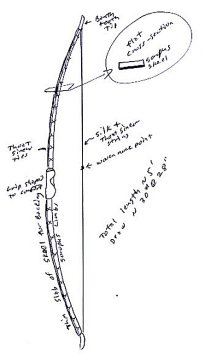 Thus I would suggest that the bow used by Kar Komak would have been
about five-feet long, made from Soropus wood with perhaps a backing of
Skeel. It would be straight (ERB mentioned ‘long bows’, not ‘deeply
curved’) but may have a slight curve at the tips to reduce shock and would
draw between 20-30 pounds at 28 inches. It would have a string made
from silk and sinew and though underpowered by Earthly requirements, on
Barsoom would have been an effective weapon.
Thus I would suggest that the bow used by Kar Komak would have been
about five-feet long, made from Soropus wood with perhaps a backing of
Skeel. It would be straight (ERB mentioned ‘long bows’, not ‘deeply
curved’) but may have a slight curve at the tips to reduce shock and would
draw between 20-30 pounds at 28 inches. It would have a string made
from silk and sinew and though underpowered by Earthly requirements, on
Barsoom would have been an effective weapon.
Having said this, I will also submit that the Barsoomian Longbow described
above would have been for ground troops and naval troops such as Kar Komak,
but what about the thoat cavalry? A Longbow would not be effective
on a thoat, thus the shorter horsebow seen above or an asymmetrical bow
such as the Japanese Yumi where the lower limb is shorter and heavier when
compared to the upper limb simply to allow them to shoot from horseback.
A horsebow must be small enough to easily be moved from side to side without
striking the saddle and when made smaller, the limbs must be enhanced.
Thus the Barsoomian Thoatbow would be of Soropus backed with thoat legbone
slabs and sinew, coated with a resin made from the joints of the thoat.
It would be much smaller than the Barsoomian longbow but as powerful, each
bow designed for a different use and environment.
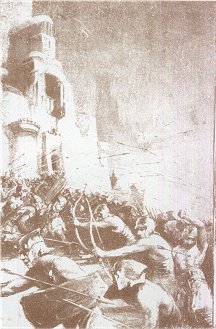
Now, about those arrows?

See all the Articles and Fiction by
Rick Johnson
at
www.erbzine.com/mag16/1645.html


